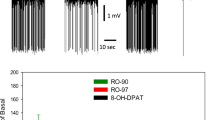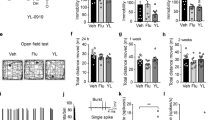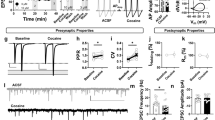Abstract
Monoamines, including both dopamine and serotonin, synapse onto prefrontal cortical interneurons. Dopamine has been shown to activate these GABAergic interneurons, but there are no direct data on the effects of serotonin on GABA release in the prefrontal cortex. We, therefore, examined the effects of the 5-HT2a/c agonist 1-(2,5-dimethoxy-4-iodophenyl-2-aminopropane (DOI) on extracellular GABA levels in the prefrontal cortex of the rat. Local infusions of DOI dose-dependently increased cortical extracellular GABA levels. In addition, systemic DOI administration resulted in Fos protein expression in glutamic acid decarboxylase67-immunoreactive interneurons of the prefrontal cortex. These data indicate that serotonin, operating through a 5-HT2 receptor, acutely activates GABAergic interneurons in the prefrontal cortex. These data further suggest that there may be convergent regulation of interneurons by dopamine and serotonin in the prefrontal cortex.
Similar content being viewed by others
Main
Anatomical studies over the past decade have illuminated the synaptic organization of monoamine-containing axons and GABAergic interneurons in the cortex. Dopamine (DA) axons form synaptic specializations with interneurons in the prefrontal cortex (PFC) (Verney et al. 1991; Smiley and Goldman-Rakic 1993; Sesack et al. 1995). Consistent with this anatomical arrangement, DA acts through a D2-like DA receptor to increase extracellular GABA levels in the PFC of the rat (Grobin and Deutch 1998) and depolarizes PFC interneurons (Yang et al. 1997; Zheng et al. 1997). We have previously found that acute administration of the atypical antipsychotic drug clozapine sharply decreases extracellular GABA levels in the PFC, and the typical antipsychotic drug (APD) haloperidol only weakly alters GABA levels (Bourdelais and Deutch 1994). The differences between the effects of the two APDs on GABA release in the PFC may be due to the potent 5-HT receptor antagonism of clozapine.
Recent anatomical data indicate that the major target of serotonin axons in the PFC is the interneuron (Smiley and Goldman-Rakic 1996). 5-HT2a and 5-HT2c mRNAs are expressed in PFC neurons, and immunohistochemical and in situ hybridization histochemical data indicate that the 5-HT2a receptor is localized to a subset of interneurons as well as pyramidal cells (Burnet et al. 1995; Willins et al. 1997; Jakab and Goldman-Rakic 1997).
The role of serotonin in regulating GABA release in the PFC has not been studied directly. Because interneurons in the PFC express 5-HT2 receptors, we examined the ability of the 5-HT2a/c agonist 1-(2,5-dimethoxy-4-iodophenyl-2-aminopropane; DOI) to alter extracellular GABA levels in the PFC, using in vivo microdialysis. In addition, in order to determine if DOI activates interneurons in the PFC, we examined the effects of DOI on Fos protein induction in GABAergic cells using immunohistochemical methods.
METHODS
Adult male Sprague–Dawley rats (Camm, Wayne, NJ, USA) were housed on a 12:12 light–dark cycle and had free access to food and water. Rats were surgically implanted with chronic in-dwelling guide cannulae into the PFC (coordinates AP +3.0 from bregma; L +2.2; DV −2.3; implanted 17° from vertical [Paxinos and Watson 1986]). Five to seven days later, microdialysis probes (260 μm o.d.) with an exchange length of 3.0 mm were inserted into the PFC in awake rats, and the probes were perfused overnight (0.2 μl/min) with artificial cerebrospinal fluid (see Grobin and Deutch 1998). The next morning, the flow was increased to 2.0 μl/min, and after a 60-min equilibration period, dialysis samples were collected every 20 min from the freely moving rats. Five 20-min samples were collected for baseline determination, after which DOI (5.0, 50, or 100 μm) was administered through the dialysis probe for 20 min, and the next seven dialysis samples were collected. Rats were sacrificed, and probe placements in the PFC were verified by examining cresyl violet-stained coronal sections cut through the PFC.
Dialysis samples were analyzed by high-performance liquid chromatography (HPLC) with electrochemical detection, using precolumn derivatization with O-phthaldialdehyde (see Bourdelais and Kalivas 1991). Raw data (fmols/μl dialysate) were analyzed for over-all significance by ANOVA with repeated measures on the time factor.
To examine the cellular targets of DOI, rats were injected subcutaneously with 5.0 mg/kg DOI or vehicle, and perfused 3 hours later with 4% paraformaldehyde. Sections were processed for immunohistochemical localization of GAD67 using a rabbit antibody (1:1000; Chemicon; Temuecula, CA, USA); a peroxidase–antiperoxidase method with diaminobenzidine as the chromogen was used, yielding a brown cytosolic reaction product. Sections were subsequently processed using an avidin–biotin immunoperoxidase method for demonstration of Fos-like immunoreactivity (-li), with diaminobenzidine in the presence of cobalt chloride and nickel ammonium sulfate yielding black Fos-like immunoreactive nuclei that were clearly visibly against the brown cytosolic reaction product for GAD67-li (see Deutch et al. 1991); a sheep antibody directed against Fos (1:6000; Genosys; The Woodlands, TX, USA) was used. The number of Fos-li neurons in a defined area of the prelimbic/infralimbic cortices was first counted, and then the number of Fos-li neurons in 100 GAD67-li neurons was counted to arrive at a percentage of interneurons expressing Fos. The numbers of Fos-li cells in the PFC of control and DOI-treated rats were compared using a t-test, and the percentage of interneurons expressing Fos-li in vehicle- and DOI-treated rats were compared using the Mann–Whitney U statistic.
RESULTS
Local PFC administration of the 5-HT2a/c agonist DOI significantly increased extracellular GABA levels in the PFC in a dose-dependent manner. Mean baseline GABA levels in the PFC were 38.3 ± 3.9 fmols/μl (not corrected for probe recovery of ≈8%). 5.0 μM DOI administration did not alter extracellular GABA levels in the PFC, but the intermediate and high doses both increased extracellular GABA levels (see Figure 1 ).
Immunohistochemical examination revealed that administration of 5.0 mg/kg DOI significantly increased the number of Fos-li neurons in the PFC (1.7 ± 0.3 Fos-li cells in vehicle-treated rats versus 35.0 ± 9.5 Fos-li cells in DOI-treated rats; t[4] = 3.51, p ⩽ .05). Double-labeling studies revealed Fos-li Nuclei in both GABAergic (GAD67-li) interneurons and in cells that did not exhibit GAD67-li and were thus considered pyramidal cells (Figure 2). DOI treatment significantly increased the percentage of GABAergic cells in the PFC that expressed Fos-li (p ⩽ .05), with vehicle-treated animals expressing Fos-li in 4.3 (±1.4) % of interneurons, as compared to DOI-treated animals expressing Fos-li in 12.3 (±1.7) % of GABAergic neurons.
DISCUSSION
Acute DOI treatment increased extracellular GABA levels and increased Fos expression in GABAergic cells of the PFC. These data are consistent with the hypothesis that serotonin, acting through a 5-HT2 receptor, activates cortical interneurons.
The ability of DOI to increase extracellular GABA levels is most likely caused by release of the transmitter from interneurons. Basal extracellular GABA levels in the PFC are partly tetrodotoxin-sensitive under our conditions in the awake, freely moving animal (Bourdelais and Deutch 1994), suggesting that some of the GABA in the dialysate is derived from nontransmitter pools of the amino acid. However, the DA agonist-evoked increase in extracellular GABA is >90% tetrodotoxin-sensitive (Grobin and Deutch 1998), suggesting that evoked GABA release is derived almost solely from the transmitter pool. This suggestion is consistent with previous data (Campbell et al. 1993).
Systemic administration of DOI increased the number of Fos-like immunoreactive neurons in the PFC, confirming the observation of Leslie et al. (1993) that DOI induces Fos expression in (uncharacterized) cortical neurons. We found that vehicle-treated rats rarely displayed Fos-li nuclei in GAD67-li cells, but in DOI-treated rats, Fos expression was observed in both interneurons and pyramidal cells. These findings are consistent with the dialysis data, and suggest that DOI specifically targets GABA interneurons as well as pyramidal cells. DOI does not induce Fos in all interneurons; further work will be necessary to determine the distinct population(s) of GABAergic interneurons that are affected.
It is unclear if the effect of DOI on GABAergic interneurons is direct or is mediated through activation of pyramidal cell collaterals. Electrophysiological data in the pyriform cortex indicate that DOI directly depolarizes interneurons (Marek and Aghajanian 1994). However, electrophysiological studies in the PFC suggest that the major effect of serotonin is on pyramidal cells (Aghajanian and Marek 1997). Because 5-HT2a receptors are present on interneurons and pyramidal cells (Willins et al. 1997; Jakab and Goldman-Rakic 1997), DOI may exert both direct and indirect effects on interneurons. In view of the data indicating that the interneuron is the major target of serotonin terminals in the PFC, (Smiley and Goldman-Rakic 1996), it is conceivable that serotonin-mediated synaptic transmission regulates GABAergic interneurons, and that nonjunctional (“paracrine”) serotonergic transmission is more critically related to pyramidal cell activity.
DOI displays high affinities for both the 5-HT2a and 5-HT2c receptors. The former are expressed on interneurons and pyramidal cells (Willins et al. 1997; Jakab and Goldman-Rakic 1997), but the cellular localization of the 5-HT2c receptor in the PFC is not known. Further work using specific 5-HT2a and 5-HT2c antagonists will unravel the relative contributions of these receptors to serotonergic regulation of GABAergic interneurons.
The ability of DOI to increase extracellular GABA levels in the PFC is consistent with the hypothesis that serotonin regulates cortical interneurons, and suggests that GABAergic mechanisms may indirectly contribute to the mechanisms of action of atypical APDs. In the rat pyriform cortex, where 5-HT2a activation depolarizes interneurons (Sheldon and Aghajanian 1991; Marek and Aghajanian 1994), atypical APDs potently block serotonin-mediated effects (Gellman and Aghajanian 1994). Acute administration of the atypical APD clozapine sharply decreases PFC GABA levels (Bourdelais and Deutch 1994), consistent with the high 5-HT2:D2 affinity ratio of clozapine (Meltzer et al. 1989).
Our data indicate that serotonin, operating through a 5-HT2 receptor, activates GABAergic interneurons in the PFC. We have recently reported that DA agonists, operating through a D2 receptor, also increase extracellular GABA levels (Grobin and Deutch 1998). Thus, DA and serotonin may coordinately regulate PFC inter-neurons, similar to the situation observed in the pyriform cortex (Gellman and Aghajanian 1993). The high 5-HT2a:D2 affinity ratio of clozapine and other putative atypical APDs (Meltzer et al. 1989) fits well with a coordinate regulation of interneurons in the PFC by serotonin and dopamine.
References
Aghajanian GK, Marek GJ . (1997): Serotonin induces excitatory postsynaptic potentials in apical dendrites of neocortical pyramidal cells. Neuropharmacology 36: 589–599
Bourdelais AJ, Deutch AY . (1994): The effects of haloperidol and clozapine on extracellular GABA levels in the prefrontal cortex of the rat: An in vivo microdialysis study. Cerebr Cort 4: 69–77
Bourdelais AJ, Kalivas PW . (1991): High sensitivity HPLC assay for GABA in brain dialysates. J Neurosci Meth 39: 115–121
Burnet PW, Eastwood SL, Lacey K, Harrison PJ . (1995): The distribution of 5-HT1a and 5-HT2a receptor mRNA in human brain. Brain Res 676: 157–168
Campbell K, Kalen P, Wictorin K, Lundberg C, Mandel RJ, Bjorklund A . (1993): Characterization of GABA release from intrastriatal striatal transplants: Dependence upon host-derived afferents. Neuroscience 53: 403–415
Deutch AY, Lee MC, Gillham MH, Cameron D, Goldstein M, Iadorola MJ . (1991): Stress selectively increases Fos protein in dopamine neurons innervating the prefrontal cortex. Cerebr Cort 1: 273–292
Gellman RL, Aghajanian GK . (1993): Pyramidal cells in piriform cortex receive a convergence of inputs form monoamine activated GABAergic interneurons. Brain Res 600: 63–73
Gellman RL, Aghajanian GK . (1994): Serotonin2 receptor-mediated excitation of interneurons in piriform cortex: Antagonism by atypical antipsychotic drugs. Neuroscience 58: 515–525
Grobin AC, Deutch AY . (1998): Dopaminergic regulation of extracellular GABA levels in the prefrontal cortex. J Pharm Exp Ther 285: 350–357
Jakab RL, Goldman-Rakic PS . (1997): 5-Hydroxytryptamine 2a serotonin receptors in the primate cerebral cortex: Possible site of action of hallucinogenic and antipsychotic drugs in pyramidal cell apical dendrites. Proc Natl Acad Sci USA 95: 735–740
Leslie RA, Moorman JM, Coulson A, Grahame-Smith DG . (1993): Serotonin2/1C receptor activation causes a localized expression of the immediate-early gene c-fos in rat brain: Evidence for involvement of dorsal raphe nucleus projection fibers. Neuroscience 53: 457–463
Marek GJ, Aghajanian GK . (1994): Excitation of interneurons in piriform cortex by serotonin (5-HT): Blockade by MDL100,907, a highly selective 5-HT2a antagonist. Eur J Pharmacol 259: 137–141
Meltzer HY, Matsubara S, Lee J-C . (1989): Classification of typical and atypical antipsychotic drugs on the basis of D-1, D-2, and serotonin2 pKi values. J Pharmacol Exp Ther 251: 238–246
Paxinos G, Watson C . (1986): The Rat Brain in Stereotaxic Coordinates, 2nd ed. San Diego, CA, Academic Press
Sesack SR, Snyder CL, Lewis DA . (1995): Axon terminals immunolabeled for dopamine or tyrosine hydroxylase synapse on GABA-immunoreactive dendrites in rat and monkey cortex. J Comp Neurol 363: 264–280
Sheldon P, Aghajanian GK . (1991): Excitatory responses to serotonin (5-HT) in neurons of the rat piriform cortex: Evidence for mediation by 5-HT1C receptors in pyramidal cells and 5-HT2 receptors in interneurons. Synapse 9: 208–218
Smiley JF, Goldman-Rakic PS . (1993): Heterogeneous targets of dopamine synapses in monkey prefrontal cortex demonstrated by serial section electron microscopy: A laminar analysis using the silver enhanced diaminobenzidinesulfide (SEDS) immunolabeling technique. Cerebr Cort 3: 223–238
Smiley JF, Goldman-Rakic PS . (1996): Serotonergic axons in monkey prefrontal cerebral cortex synapse predominantly on interneurons as demonstrated by serial section electron microscopy. J Comp Neurol 367: 431–443
Verney C, Alvarez C, Geffard M, Berger B . (1991): Ultrastructural double-labeling study of dopamine terminals and GABA-containing neurons in rat anteromedial cerebral cortex. Eur J Neurosci 2: 960–972
Willins DL, Deutch AY, Roth BL . (1997): Serotonin 5-HT2A receptors are expressed on pyramidal cells and interneurons in the rat cortex. Synapse 27: 79–82
Yang CR, Seamans JK, Goreleva N . (1997): Mechanisms of dopamine (DA) modulation of GABAergic inputs to rat layer V-VI pyramdial prefrontal cortical (PFC) neurons in vitro. Soc Neurosci Abstr 23: 1771
Zheng P, Bunney BS, Shi W-X . (1997): Electrophysiological characterization and effect of dopamine on visually identified nonpyramidal neurons in the prefrontal cortex. Soc Neurosci Abstr 23: 1212
Acknowledgements
We thank A. Chistina Grobin for her help, advice, and encouragement, Cheryl D. Young for helpful discussions, and Dorothy Cameron for technical assistance. This work was supported by a VA Psychiatry Research Fellowship (WMA-S), a NARSAD Young Investigator Award (WMA-S), and grants MH-14092 (RHR), MH-57995 (AYD), and MH-45124 (AYD).
Author information
Authors and Affiliations
Rights and permissions
About this article
Cite this article
Abi-Saab, W., Bubser, M., Roth, R. et al. 5-HT2 Receptor Regulation of Extracellular GABA Levels in the Prefrontal Cortex. Neuropsychopharmacol 20, 92–96 (1999). https://doi.org/10.1016/S0893-133X(98)00046-3
Received:
Revised:
Accepted:
Issue Date:
DOI: https://doi.org/10.1016/S0893-133X(98)00046-3
Keywords
This article is cited by
-
Neurochemical and Behavioral Effects of a New Hallucinogenic Compound 25B-NBOMe in Rats
Neurotoxicity Research (2021)
-
Hallucinogen-Like Action of the Novel Designer Drug 25I-NBOMe and Its Effect on Cortical Neurotransmitters in Rats
Neurotoxicity Research (2019)
-
Regulating Prefrontal Cortex Activation: An Emerging Role for the 5-HT2A Serotonin Receptor in the Modulation of Emotion-Based Actions?
Molecular Neurobiology (2013)
-
Time-dependent effects of haloperidol on glutamine and GABA homeostasis and astrocyte activity in the rat brain
Psychopharmacology (2013)
-
Augmentation of SSRI Effects on Serotonin by 5-HT2C Antagonists: Mechanistic Studies
Neuropsychopharmacology (2007)





